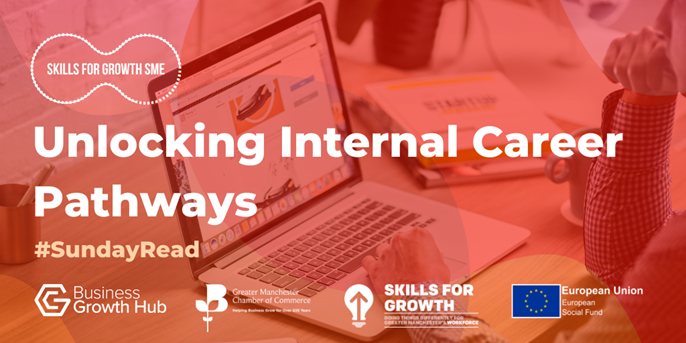Marketing Apprentice on the Skills for Growth - SME Support programme.

Unlocking Internal Career Pathways
What does it take for an SME to replace a salaried employee? A study from the Society for Human Resource Management found that every time a business replaces a salaried employee, it costs 6 to 9 months’ salary on average, so for a manager making £40,000 a year, £20,000 to £30,000 in recruiting and training expenses. Rather than focusing outwards and reacting to staff turnover when it becomes inevitable, in this article we’ll be focusing on unlocking internal career pathways for your existing employees, with a focus on retention and employee engagement.
A Summary of Career Pathways
First, let’s define what we mean by career pathways. We see this as planning and mapping the progression, learning and development of individuals beyond joining the company, giving them a future to focus on. In a 2019 LinkedIn Workforce Learning Report, they found that 94% of people would stay at a company longer if it invested in helping them learn. Learning keeps staff engaged, challenged, and developing, and even if there isn’t an immediate promotion to work towards, learning can provide a sense of direction towards future growth. Managers can develop internal developmental routes by conducting review sessions with their team, focusing on what they want out of their future within the company and identifying the skills and experience they’ll need to help them reach their goals.
The Benefits
There are many benefits to developing internal career pathways, including:
- Attract top talent – Positioning development as a benefit will increase the likelihood of finding applicants who share the same values of growth and development at work as you do.
- Redirect costs into investing in a loyal workforce – Rather than expending on outsourcing for new candidates, it pays to recognise the training and development needs of your existing staff and reward them with the opportunity to grow.
- Develop a positive workplace culture – Creating steps towards progression into higher roles will develop a positive workplace culture as employees can clearly see how they can move around the business.
- Employees feel valued – Developing internal career pathways shows employees that you care about them as people, which will make them feel valued by the company.
- More productive workforce – Employees will be better skilled and effective in their roles, leading to a more productive workforce, directly benefitting the business in both the short and long term.
How to Create Internal Career Pathways
Implementing career development pathways for your staff requires a comprehensive plan, and at Skills for Growth – SME Support, we can help you to put this in place. First off, here are a few steps you can take on your own.
-
Create an organisational chart
Mapping out all the roles within your business and how they align with each other in the organisational hierarchy is an essential first step. Understanding your organisational structure allows you to spot areas where you can create progression verticals and redirections. For example, a career vertical could be Marketing Assistant - Marketing Executive - Senior Marketing Executive - Marketing Manager – Senior Marketing Manager – Marketing Director and so on, with horizontal and dotted lines into specialisms such as PPC Manager, SEO Specialist, Event Manager etc. Consider the long-term objectives of the business and whether your structure supports your objectives and needs.
-
Clearly define the job roles and skills
Once you have established the roles in your organisation and how they fit into the hierarchy, writing clear, well-defined job descriptions will help you to figure out what educational requirements or practical skills are needed for each position. This way, you will have a clearer definition of the necessary training and qualifications for staff to progress to the next level.
-
Tailored development plans
Consult with current employees and new hires to determine their career goals, and how they match up with long-term objectives for both the business, and the future roles that may be available to them. Based on each employee’s goal, create a learning/training map that includes any required skills they may need to perform better in their current role, or to progress in the future. This should provide some incentive and motivation to the individual, demonstrating your investment in their personal and professional development.
Skills for Growth – SME Support can help you upskill your employees and examine your organisational structure to identify any skills gaps within your team. Click here to apply for our fully funded support service or call 0161 237 4444 and speak to a Skills Coach today.
